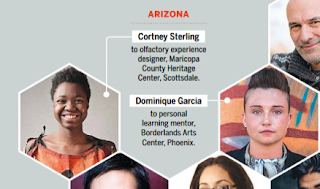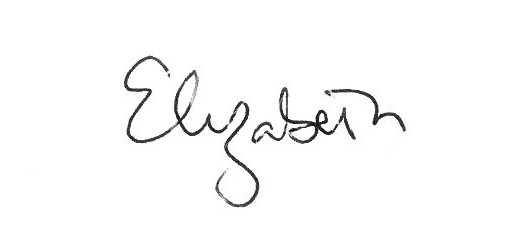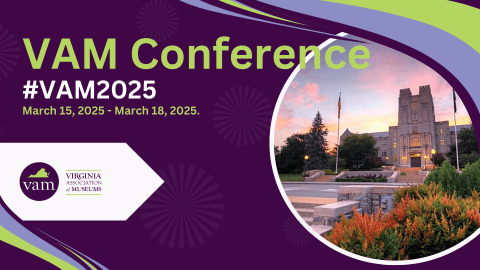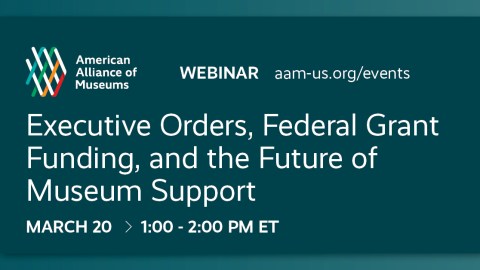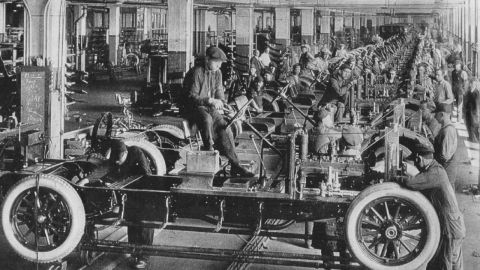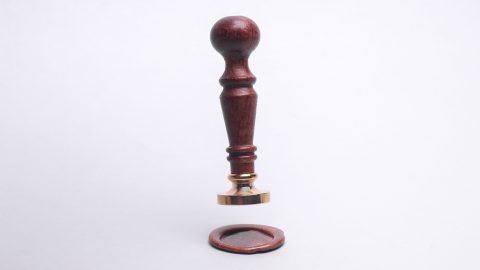The November/December issue of Museum mailed out yesterday, as well as going up on the web. (This issue of the magazine is available as a free download for members and non-members alike). When you open your print or digital copy, you may notice something a little odd. We published this edition a little early—23 years early, to be exact.
This bit of chronological legerdemain serves as prelude to the tenth anniversary of the Center for the Future of Museums, which falls in 2018. The goal of this exercise in “future fiction” is to help you investigate one possible future and think about how our organizations might respond. As you read the stories in this issue, I hope you ask yourself, “Do I think this could happen? Do I want this to happen?” And, perhaps most importantly, “Does this have to wait until 2040, or can I make it happen now?”
I hereby award futurist points to any reader who asks “in which version of the year 2040 do these stories take place?” Of course one of the main purposes of strategic foresight is to help us think about manyplausible ways the future could play out. This issue of Museum is set in one specific future that might result from existing limits and challenges playing out over coming decades. This scenario, dubbed A New Equilibrium, was developed with the input of many people inside and outside the museum field, drawing on mainstream research and projections on demographics, technology, the economy, environment and other sectors. For example, in this version of 2040:
-
The US population is older and more diverse than it is now. The ratio of retired people to people of working age (so-called “old-age dependency”) has climbed to 38% from 25% in 2017.
- Economic stratification has continued to grow in the past few decades. The top 10% of families now hold 85% of the wealth in the US, while the bottom 60% hold 1%.
- In education, there has been significant growth in the number of private schools, and charter schools now serve 15 percent of the public school population (triple the number in 2014).
- Impact philanthropy has become the dominant guiding principle of individual and foundation funding, and nonprofits are expected to provide concrete, measurable data of how they have improved the environment, or people’s lives, in order to secure support.
In the face of these challenges, museums have prospered. Attendance is robust, our organizations are financially stable, and our visitors, staff, and board members reflect our communities.
The scenario in place, I sent an invitation out through the Alliance’s professional networks for people willing to immerse themselves in this version of the future, writing content that explores what museums are doing in order to thrive in the face of these challenges. There were a few ground rules:
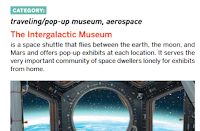 |
Congratulations to the newly accredited museums
of 2040 |
Authors had to stay within the bounds of this particular scenario: a future created by current trends playing out over the next decades. For example, they could posit colonies on the Moon or Mars. (After all, Elon Musk is spending billions on his plans to colonize Mars, hoping to launch the first flights in the 2020s). However, they couldn’t introduce massively disruptive events such as a global fatal pandemic disease or a nuclear world war III, or invoke the most extreme estimates regarding climate change.
Authors were only permitted to use the names of real museums if they themselves represented that institution, or obtained permission from the organization in question. For this reason, you may notice many, many museums with names similar, but not identical, to existing organizations.
Authors could write as themselves (from the perspective of being 23 years older than they are now), or they could invent fictional personas reflecting people they imagine will be working in our field by that time. For example, Sarah Sutton attributes her opinion piece on museums, equity, and environmental sustainability to an environmental activist named Ocean Six.
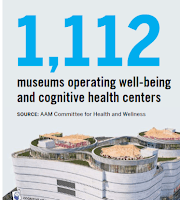 Given these prompts and these constraints, what stories did people invent? In addition to Sarah’s (sorry, Ocean’s) musings on the next frontier of green, that is. Rachel Hatch, program officer for community vitality at the McConnell Foundation, gives us a funder’s take on how museums are supporting the creative economy in 2040, envisioning how universal basic income might create a cadre of “citizen artists.” Adam Rozan’s keynote from the AAM 2040 annual meeting explores how the very concept of “museum” has changed over time, coming to encompass roles that used to be siloed in libraries, community centers, schools, and places of worship. Omar Eaton-Martinez writes about the newly formed US Truth and Reconciliation Commission, and the role museums can play in healing and remembrance. (In this future, Omar holds the position of secretary of the Smithsonian Institution where he is, in the present, intern and fellows program manager for the National Museum of American History. And President-elect Sanai Eaton-Martínez, who is creating the TRC? That’s his daughter. ?)
Given these prompts and these constraints, what stories did people invent? In addition to Sarah’s (sorry, Ocean’s) musings on the next frontier of green, that is. Rachel Hatch, program officer for community vitality at the McConnell Foundation, gives us a funder’s take on how museums are supporting the creative economy in 2040, envisioning how universal basic income might create a cadre of “citizen artists.” Adam Rozan’s keynote from the AAM 2040 annual meeting explores how the very concept of “museum” has changed over time, coming to encompass roles that used to be siloed in libraries, community centers, schools, and places of worship. Omar Eaton-Martinez writes about the newly formed US Truth and Reconciliation Commission, and the role museums can play in healing and remembrance. (In this future, Omar holds the position of secretary of the Smithsonian Institution where he is, in the present, intern and fellows program manager for the National Museum of American History. And President-elect Sanai Eaton-Martínez, who is creating the TRC? That’s his daughter. ?)
Nicole Ivy, the Alliance’s director of inclusion, took over the Community section of the magazine, crowdsourcing input on what museum jobs might exist in 2040. (My favorites include poet-in-residence, digital fabrication specialist, and spiritual services director.) Together, Nicole and I tried to ensure that the magazine as a whole reflects the diversity—of race, culture, age and (non-binary) gender—we hope will come to characterize our field.
Though it is immense fun, writing from the future did pose some challenges, notably the willingness to relinquish control! While I took the liberty of writing a few key elements into the issue, our authors were the primary world-builders. As supporting researcher, I tackled another key challenge, looking for credible projections from mainstream sources to feed the writers’ work. For example, at the Bureau of Labor Statistics I found projections on labor participation that assess the impact of a growing population that is both older and more diverse. Several authors wanted to flood various areas of the country, and we spent hours manipulating the Surging Seas Risk Zone Map to test their propositions. One of the hardest things to project is the rate of adoption of a given technology. Roy Amara at the Institute of the Future formulated Amara’s Law, which states that we tend to overestimate the impact of new technology in the short term, underestimate it in the long term. Many, many of the 2040 authors wrote about virtual reality—which, of course, is an exciting, shiny technology just beginning to come into its own. By 2040, will it be so embedded in our lives as to be unremarkable, still struggling to go mainstream, or will it have fizzled out? Read the issue to see what our authors envision for museums and VR.
Another challenge was maintaining internal consistency. Authors were given free rein to embellish this future, adding details in keeping with the spirit of the scenario’s parameters. This necessitated much tweaking as we tried to bring the details of different articles into alignment. At the twenty third-and-a-half hour, I was frantically texting authors from the airport as we tried to resolve contradictory statements regarding museum visitation in two of the features. I wouldn’t be surprised if a reader with an eye for detail finds inconsistencies we missed—please point them out.
My enduring thanks to all the authors who spent countless hours polishing their pieces (and for their patience with my suggested edits and tweaks.) There is a full list of their actual identities on page 54. I am particularly to Susie Wilkening for creating the two-page By The Numbers overview of this future and for helping me search for all sorts of credible “numbers” to flesh out our scenario. And I want to give a shout-out to all the advertisers who supported this unconventional issue, particularly those who played along with the scenario. You will see their visions of future products and services scattered throughout.
Museum 2040 is only the beginning of a much longer exploration of this and other potential futures. In coming months, I will use the CFM Blog to share additional content riffing on the New Equilibrium scenario: authors sharing the thought process behind their stories as well as additional future fiction. Some essays will explore interesting plot points appearing in the magazine stories, such as the link between universal basic income and citizen artists; potential museum uses for the open, secure, distributed digital ledgers supported by blockchain; and the role of museums in national reconciliation.
You can play too! Enjoy the full issue, with our compliments, by downloading a free PDF copy here. In addition to reading and discussing the contents in your workplace, I encourage you to put your digital pen to paper and try your own hand at immersive future fiction. You can access a synopsis of the New Equilibrium scenario here, to inform your storytelling. Pitch your ideas using the comment section, below, or email me at emerritt (at) aam-us.org with the subject line Museum 2040.
As part of our tenth anniversary celebration, CFM will publish scenarios describing other potential futures—bright and dark, mainstream and unexpected—throughout 2018, together with a guide to using these stories as a tool for institutional planning. I look forward to helping you imagine the many ways these futures may play out, as well as the strategies museums will create to thrive no matter what comes.
Elizabeth Merritt

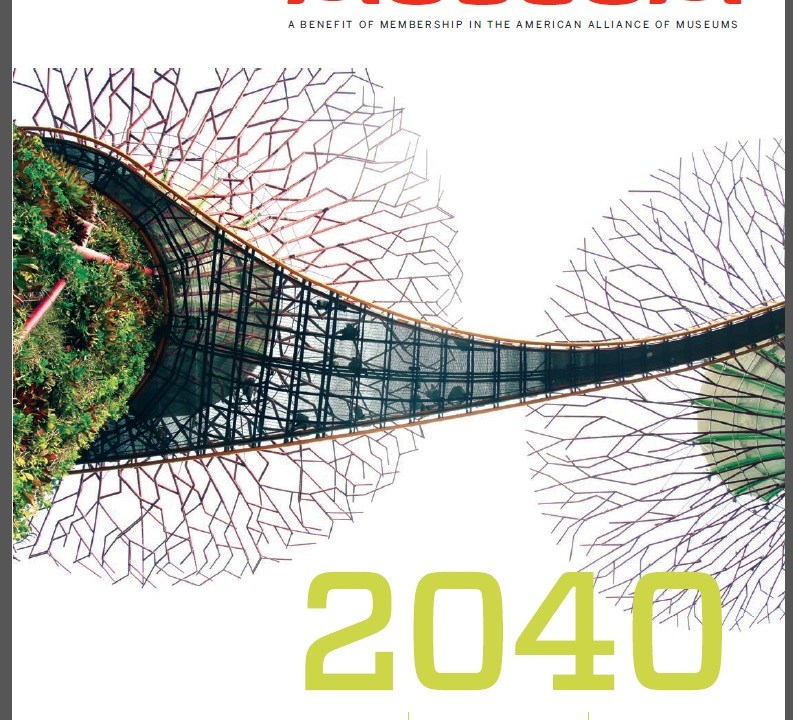

 Given these prompts and these constraints, what stories did people invent? In addition to Sarah’s (sorry, Ocean’s) musings on the next frontier of green, that is. Rachel Hatch, program officer for community vitality at the McConnell Foundation, gives us a funder’s take on how museums are supporting the creative economy in 2040, envisioning how universal basic income might create a cadre of “citizen artists.” Adam Rozan’s keynote from the AAM 2040 annual meeting explores how the very concept of “museum” has changed over time, coming to encompass roles that used to be siloed in libraries, community centers, schools, and places of worship. Omar Eaton-Martinez writes about the newly formed US Truth and Reconciliation Commission, and the role museums can play in healing and remembrance. (In this future, Omar holds the position of secretary of the Smithsonian Institution where he is, in the present, intern and fellows program manager for the National Museum of American History. And President-elect Sanai Eaton-Martínez, who is creating the TRC? That’s his daughter. ?)
Given these prompts and these constraints, what stories did people invent? In addition to Sarah’s (sorry, Ocean’s) musings on the next frontier of green, that is. Rachel Hatch, program officer for community vitality at the McConnell Foundation, gives us a funder’s take on how museums are supporting the creative economy in 2040, envisioning how universal basic income might create a cadre of “citizen artists.” Adam Rozan’s keynote from the AAM 2040 annual meeting explores how the very concept of “museum” has changed over time, coming to encompass roles that used to be siloed in libraries, community centers, schools, and places of worship. Omar Eaton-Martinez writes about the newly formed US Truth and Reconciliation Commission, and the role museums can play in healing and remembrance. (In this future, Omar holds the position of secretary of the Smithsonian Institution where he is, in the present, intern and fellows program manager for the National Museum of American History. And President-elect Sanai Eaton-Martínez, who is creating the TRC? That’s his daughter. ?)

